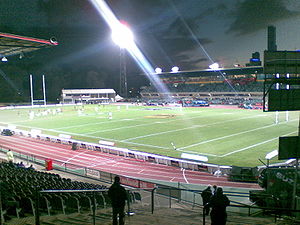Olympic Park Stadium (Melbourne)
Olympic Park, The Graveyard | |
 | |
 | |
| Location | Olympic Bvd, Melbourne, Victoria |
|---|---|
| Owner | Melbourne Olympic Parks Trust |
| Operator | Melbourne Olympic Parks Trust |
| Capacity | 18,500 |
| Surface | Grass Athletics Track |
| Opened | 1956 |
| Tenants | |
| Melbourne Storm (NRL) (1998-2000, 2002-) | |
Olympic Park Stadium is a multi-purpose outdoor stadium located in Olympic Boulevard in inner Melbourne. The stadium was built as an athletics training venue for the 1956 Olympics.[1]
The stadium currently plays host to Rugby League team Melbourne Storm and to athletics.
On 4 March 2008, it was reported that Australian Rules Football club president, Eddie McGuire was attempting to take-over the stadium and utilise the facilities as a training ground for his Collingwood team[2].
Current Usage
The stadium is one of the largest in Victoria primarily suited to rectangular configuration, making it ideal for hosting rugby league, rugby union, football (soccer) and gridiron. The larger Telstra Dome and Melbourne Cricket Ground also support rectangular configuration, but with less ideal viewing conditions. A larger 31,000 seat Melbourne Rectangular Stadium is under construction adjacent to Olympic Park Stadium and is due for completion in 2009.
The stadium has lighting suited for night matches. The stadium has a top class athletics track that was refurbished in 1997, with the stadium last being redeveloped in 1998.
The stadium is currently host to (NRL) and athletics meetings conducted by Athletics Victoria. It served as the home of Melbourne Victory (A-League) home games for two seasons (2005-2007).
Olympic Park has a capacity of 18,500 spectators with 11,000 seats.[3]
Athletics
Australian athletes have competed on the track for over fifty years and the venue has hosted twelve National Championships[4].
Thirteen world records in athletics have been established at the track with Pole vaulter Emma George setting four between 1995 and 1998[5].
Australian middle distance star John Landy featured in a memorable race at the 1956 National Championships, where he stopped during the Mile championship to assist the fallen junior champion, Ron Clarke. Landy's actions, in front of a 22,000 strong crowd[6] have been described as 'the finest sporting moment in the history of sport'[7]. Landy went on to win the event with many commentators believing that the stop had cost him the world record.
A photograph of the fall was named the 'Best Australian Sporting Photo of the Twentieth Century'[7] while Landy's conduct was named by the Sport Australia Hall of Fame as the nation's finest sporting moment of the 20th Century[8].
The track is host to the most significant athletics meeting in Australia each year, the IAAF World Athletics Series, Melbourne, meet [9]. This event was previously known as the Telstra A-Series meet.
Football (soccer)
In the past the stadium has held FIFA World Cup qualification matches, NSL Grand Finals also it was the home ground for Melbourne Knights. It is the first and only[1] stadium in Australia to be recognised officially by FIFA. Melbourne Victory FC moved out of the stadium as of 2007, where they have moved to the much larger capacity Telstra Dome to accommodate the larger crowds they were attracting.
From the 2009-10 season of the A-League onwards, the Victory will move half of their home games to a purpose-built stadium situated at Olympic Park. There was some controversy as to whether the team would actually move there or not due to the stadium still being too small to accommodate the Victory's average crowd, however the construction would have gone ahead regardless of whether they decided to join as a tenant or not.[10]
Rugby League

The stadium has hosted several rugby league international matches and is currently home to the Melbourne Storm.
The Western grandstand is named the "Glenn Lazarus stand" after the Storm's foundation captain and the Eastern grandstand is named the "Tawera Nikau stand" after the legendary Melbourne forward. Local fans have unofficially dubbed the Northern end standing room, the "Marcus Bai stand" after one of the Storm's most popular players and outstanding wingers.
The Melbourne Storm's nickname for the stadium is "The Graveyard", due to their excellent record at this stadium. Melbourne Storm will also follow in 2010 and both will move into the new stadium. [3] , as the stadium is poorly suited for rugby league as the dimensions of the pitch is too small. They have currently moved administration and training to Carlton's Princes Park temporarily until the new Melbourne Rectangular Stadium is ready.
Rugby Union
The stadium has hosted several rugby union international matches and was home to the now defunct Melbourne Rebels in 2007.
Other sports
The stadium has also hosted Gridiron Victoria "Vic Bowl"s between 1985-1993.
References
- ^ a b Melbourne and Olympic Parks - Olympic Park Stadium Cite error: The named reference "MOPT" was defined multiple times with different content (see the help page).
- ^ Melbourne Herald Sun Olympic Park grab for Collingwood
- ^ a b Austadiums - Melbourne Olympic Park Cite error: The named reference "Austadiums" was defined multiple times with different content (see the help page).
- ^ Athletics Australia - National Championships
- ^ - Atletics Australia - list of world records]
- ^ Sydney Morning Herald - Landy took it all in his stride
- ^ a b National Centre for History Education
- ^ Athletics Australia - John Landy
- ^ Athletics Australia - IAAF World Series Melbourne
- ^ Whinnett, Ellen (January 31, 2007). "Bracks firm on stadium plan". Herald Sun. Retrieved 2007-02-01.
External links
- Olympic Park Official Website
- Olympic Park Stadium at Austadiums
